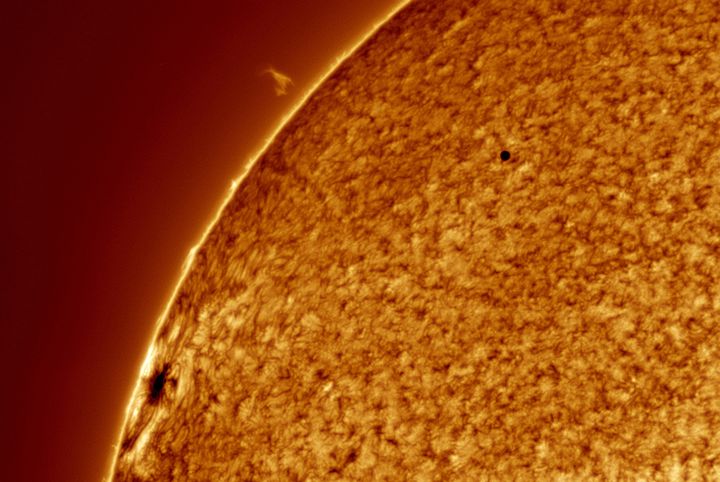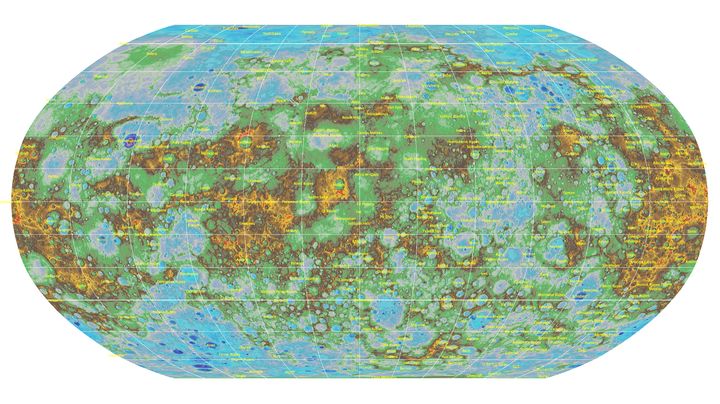LIVESTREAM: See Mercury's Transit Across The Sun
The next time our solar system will see such an event will be in 2019, and after that, 2032. The transition only takes place between 13 - 14 times a century.
Normally Mercury passes across the sun every 88 days, but usually is at the wrong angle meaning we can't see it.
NASA advises not to look at the phenomenon without a solar filter or certified eclipse sunglasses.
To most people it will look like a dot because Mercury is 285 times smaller than the sun, and if you are in New Zealand, Australia and Indonesia, you will not be able to see it.

Over seven and a half hours, Mercury's journey across the sun will be visible across north-western Africa, western Europe and most of the US.
If you'd like to see the transition, the European Space Agency will be running a feed here, NASA will be running a real-time satellite feed here, and the Royal Astronomical Society has a list of observatories here.

"The highest elevation on the planet is located just south of the equator, and about 2.5 miles above Mercury's average elevation.
"The lowest elevation, which is more than three miles below Mercury’s average, is found on the floor of Rachmaninoff basin, a basin suspected to host some of the most recent volcanic deposits on the planet."
The data was gathered with the Messenger spacecraft, which made 4,104 orbits around the planet, delivering more than 100,000 images the USGS scientists processed to produce the maps.

Here NASA explains how the transition will work:
Facts about Mercury from Space Facts:
Mercury is the second densest planet. Even though the planet is small, Mercury is very dense. Each cubic centimetre has a density of 5.4 grams, largely due to Mercury being composed mainly of heavy metals and rock.
Mercury has wrinkles. As the iron core of the planet cooled and contracted, the surface of the planet became wrinkled. Scientist have named these wrinkles, Lobate Scarps. These Scarps can be up to a mile high and hundreds of miles long.
Mercury has a molten core: In recent years scientists from NASA have come to believe the solid iron core of Mercury could in fact be molten. Normally the core of smaller planets cools rapidly, but after extensive research, the results were not in line with those expected from a solid core. Scientists now believe the core to contain a lighter element such as sulphur, which would lower the melting temperature of the core material. It is estimated Mercury’s core makes up 42% of its volume, while the Earth’s core makes up 17%.
Mercury is only the second hottest planet. Despite being further from the Sun, Venus experiences higher temperatures. The surface of Mercury which faces the Sun sees temperatures of up to 427°C, whilst on the alternate side this can be as low as -173°C. This is due to the planet having no atmosphere to help regulate the temperature.
Mercury is the most cratered planet in the Solar System. Unlike many other planets which “self-heal” through natural geological processes, the surface of Mercury is covered in craters. These are caused by numerous encounters with asteroids and comets.
Only two spacecraft have ever visited Mercury. Owing to its proximity to the Sun, Mercury is a difficult planet to visit. During 1974 and 1975 Mariner 10 flew by Mercury three times, during this time they mapped just under half of the planet’s surface. On August 3rd 2004, the Messenger probe was launched from Cape Canaveral Air Force Station, this was the first spacecraft to visit since the mid 1970’s.
Mercury is named for the Roman messenger to the gods. The exact date of Mercury’s discovery is unknown as it pre-dates its first historical mention, one of the first mentions being by the Sumerians around in 3,000 BC.
For more visit the website.
